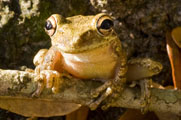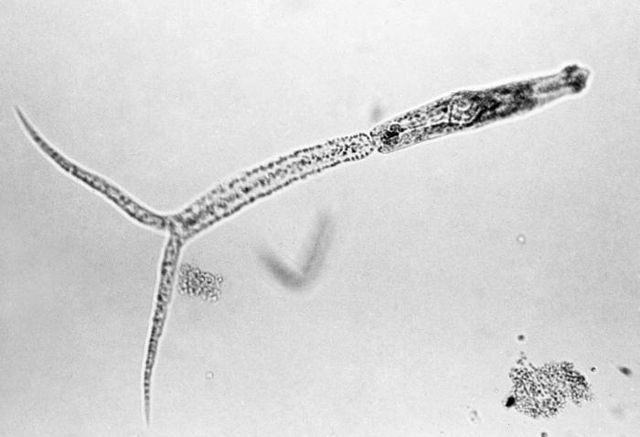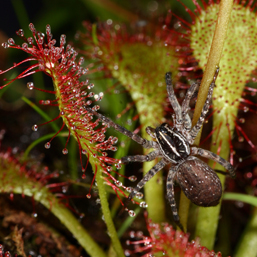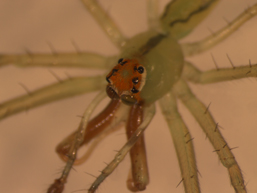

Rohr Laboratory of Ecology and Public Health
| Arthropod Biodiversity and Invertebrate-Plant Interactions |
||
A wolf spider (Sosippus floridanus) crawling on a pink sundew (Drosera capillaris) (Photo credit: Christopher V. Anderson)
A magnolia green jumper (Lyssomanes viridis) that strolled into the lab |
Research and Publications |
|
Invertebrates provide the majority of ecosystem services; thus, it is important that they be inventoried, monitored, and protected. However, inventories, monitoring, and management generally focus on vertebrates and flowering plants. Consequently, there are few guidelines or case studies for invertebrates, despite the fact that they represent the demonstrable majority of the most threatened species (e.g. Kim 1993; Kellert 1993; Goldstein 2004). Indeed, most past and predicted extinctions are of insects (Dunn 2005). We produced guidelines for developing monitoring programs for invertebrates, have considered the impacts of management practices on terrestrial arthropod diversity, and have predicted the impacts of loss of eastern hemlocks due to the invasive hemlock woolly adelgid on arthropod diversity. My collaborators and I are intimately aware of the difficulty of managing and monitoring the vast diversity of arthropods in most systems. We are working towards identifying and verifying short cuts, such as indicator or surrogate taxa, that can predict the diversity of all other arthropods in ecosystems and are investigating the scales and context-dependencies of these relationships. More specifically, we are particularly interested in interactions between spiders and carnivorous plants and fungal plant interactions. A former PhD student, David Jennings, studies interactions among distantly-related taxa, in particular spiders, carnivorous plants, and amphibians, all of which consume similar-size arthropod prey. With colleagues, we also have studied factors involved in the distribution of arbuscular mychorrhizal fungi. Sample Publications Douglas, M.R.*, Rohr, J.R., Tooker, J.F. 2015. Neonicotinoid insecticide travels through a soil food chain, disrupting biocontrol of non-target pests and decreasing soybean yield. Journal of Applied Ecology 52:25-260 Editor’s Choice, cover photo, and commentary (http://www.journalofappliedecology.org/view/0/editorschoice521.html; Altmetric score of 105, 99th percentile and top 10 ever for the journal as of 6/2015) Leslie, T.W., Rohr, J.R., Biddinger, D.J., Hulting, A.J., Mortensen, D.A., Fleischer, S.J. 2014. Examining shifts in Carabidae assemblages across a forest-agriculture ecotone. Environmental Entomology 43:18-28 Venesky, M.D.†, Mendelson, J.R., Sears, B.F.*, Stiling, P.D., Rohr, J.R. 2012. Selecting for tolerance against pathogens and herbivores to enhance the success of reintroduction and translocation programs. Conservation Biology 26: 586-592 Jennings, D.E.*, Congelosi, A.M.§, Rohr, J.R. 2012. Insecticides reduce survival and the expression of traits associated with carnivory of carnivorous plants. Ecotoxicology 21: 569-575 Lekberg, Y., Meadow, J., Rohr, J.R., Redecker, D., Zabinski, C.A. 2011. Importance of dispersal and thermal environment for mycorrhizal communities: Lessons from Yellowstone National Park. Ecology. 92: 1292-1302 Jennings, D.E.*, Rohr J.R. 2011. A review of the conservation threats to carnivorous plants. Biological Conservation. 144: 1356-1363 Jennings, D.E.*, Krupa, J.J., Raffel, T.R.†, Rohr, J.R. 2010. Evidence for competition between carnivorous plants and spiders. Proceedings of the Royal Society B - Biological Sciences. 277: 3001-3008 Rohr, J.R., Mahan, C.G., Kim, K. 2009. Response of arthropod biodiversity to foundation species declines: the case of the eastern hemlock. Forest Ecology and Management. 258: 1503-1510 Delphia, C.M.*, Rohr, J.R., Stephenson, A.G., De Moraes, C.M., Mescher, M.C. 2009. Effects of genetic variation and inbreeding on volatile production in a field population of horsenettle. International Journal of Plant Sciences 170: 12-20 Tooker, J.F.†, Rohr, J.R., Abrahamson, W.G., De Moraes, C.M. 2008. Gall insects can avoid and alter indirect plant defenses. New Phytologist. 178: 657-671 Leslie, T.W., Hoheisel, G.A., Biddinger, D.J., Rohr, J.R., Fleischer, S.J. 2007. Transgenes sustain epigeal biodiversity in diversified vegetable farm systems. Environmental Entomology. 36: 234-244 Rohr, J.R., Kim, K., Mahan, C. 2007. Developing a monitoring program for invertebrates: guidelines and a case study. Conservation Biology. 21: 422-433 Lekberg, Y.†, Koide, R.T., Rohr, J.R., Aldrich-Wolfe, L., & Morton, J.B. 2007. Role of niche theory and dispersal in the composition of arbuscular mycorrhizal fungal communities. Journal of Ecology 95: 95-105 For a full list of publications, please see the Publications page on this website. |
||

